Selections from interviews asking about my painting and my writing.
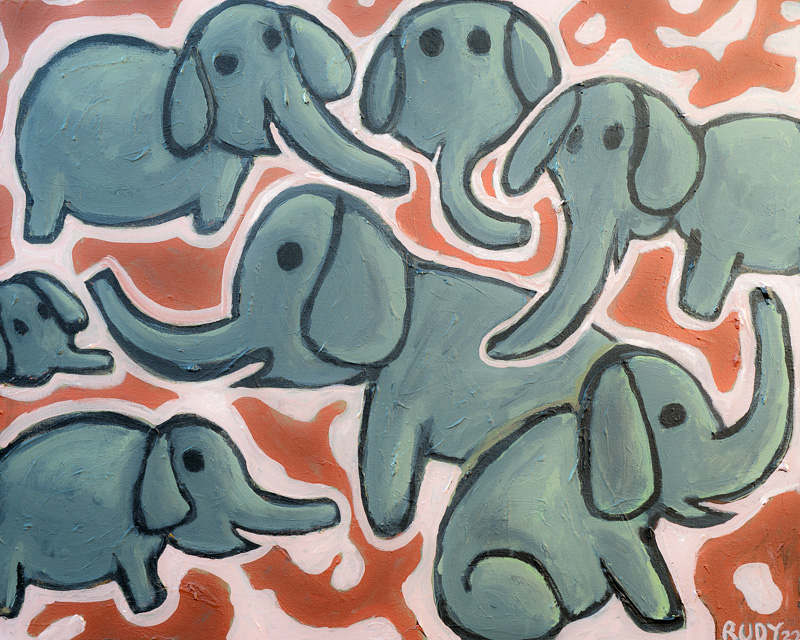
#217. Elephants.
2009. Interview by Charlie Jane Anders for io9.
Q. Do you think your writing changed when you started painting a lot?
A. All along, I’ve made little pen and paper drawings of my scenes before writing them, but now I enjoy the more heavy-duty process of breaking out my kit of acrylic paints. I took up painting when I was writing my historical novel about the painter Peter Bruegel, and I started using paintings for pre-visualization while I wrote Frek and the Elixir.
A painting takes longer than a drawing, and I get more deeply into it. My sense is that I’m using a different part of my brain when I paint a picture - as opposed to when I’m revising my written outline. It’s like visiting a different muse. I get tired of thinking all the time, and when I don’t know what to put into an upcoming scene, it’s nice to just get out the paints and see what happens.
Whether I’m writing or painting, I don’t necessarily know exactly what I’m going to come up - but painting gives me a different way being surprised. Painting has taught me a few practical things about writing as well. When I’m doing a painting, for instance, it’s not unusual to completely paint over some screwed-up some bit of it and start over. I think this has made me feel more relaxed about revising my fiction. And I’ve also noticed that the details that I haven’t yet visualized are the ones that give me the most trouble - but that the only way to proceed is to put it down wrong, and then keep changing it until it works.
Q. Do you think that working as an artist helps your writing to be more visual? Do you think it helps you have an eye for the telling detail or the vivid description? You’ve always had really surreal imagery in your books, but do you think it’s gotten more visual and less cerebral with books like Postsingular?
A. I’ve always sought to provoke the reader with a steady flow of powerful images. And, at the same time, I like to keep things moving with action, dialog, and the stream of consciousness of the main character. Absorbing a story is quite different from looking at a painting. With a painting you have a synoptic view, that is, you can overview the whole scene at once. But in reading a story, you have to build the scene in your head by processing a linear sequence of descriptions. I don’t like to overdo the visual description in the “fine writing” sense, which can be a pain for the reader. My goal is to put in just enough description so that when the reader looks back on the scene, they have a mental image similar to the one I started with. I don’t mean that I want to be stark or minimalist, what I mean is that I like the conciseness of poetry - where you line up exactly the right words and phrases to set off the intended response.
Q. Is the visual a big part of “world building” for you? Do you visualize your settings and scenes as images before you start to think of them as places where stuff occurs?
A. All along, I’ve had a visual imagination. For me writing is a little like dreaming while I’m awake. That is, I see the scene in my mind’s eye before I write it. Sometimes I’ll nurse an image of a place or a situation for quite some time before I write about it, in fact I sometimes write a book simply to be able to mentally visit certain locales that I’ve dreamed up. I pretty much can’t write a novel unless I have an image of a fabulous place where I want to go. By writing about these scenes, I make them more real to myself. And painting is another way to layer on more details.
Q . When you’re dealing with a fantastical topic, like a post-singularity world or robots on the moon, do you think having a strong visual sense is one way to ground the narrative and make it feel more real?
A. Oh yeah, everything has to be visual. I think I learned that from Robert Sheckley and Jorge Luis Borges. Ideas are important, but what you want in a novel is an objective correlative for the idea. You don’t want to go on and on about your bogus scientific explanations, you want to show the reader some weird little physical device. Imagine, say, a wriggly green horseshoe with antennae on it, call it a jinker - and when you point your jinker at some object, the target object becomes weightless and the size of a matchbox and you can carry it off in your pocket. Maybe the jinker talks to you telepathically, maybe pairs of jinkers like to get together and mate, and while they’re doing it, all the objects in your house are floating around and changing size. That’s all much more interesting than talking about spatial metrics and gravity tensors!
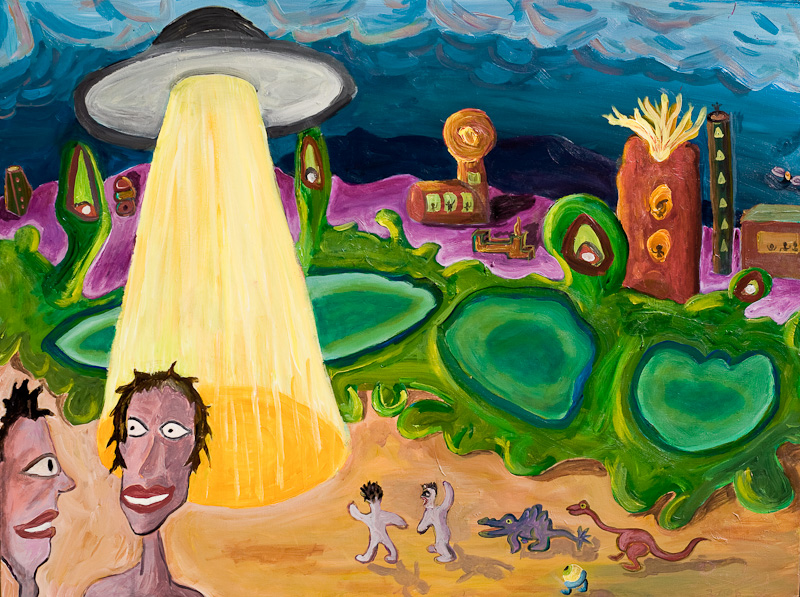
#47. Welcome to Mars
2009. Interview by Henry Baum for Self-Publishing Review.
Q 282. What’s your relationship to painting versus writing fiction? It’s great to see the cross-pollination of the painting The Sex Sphere on the cover of the novel of the same name, but I notice a much different style in your painting than in your novels. Like Welcome to Mars can be described as a kind of childlike utopia and your novels don’t really fit that description.
A 282. In my own head, my paintings look very much like the scenes in my novels. Since I’m known as a cyberpunk, people sometimes imagine that my novels are dark and full of machines, but that’s not the kind of book I’m writing these days. In recent years I’ve become interested in scenarios where the machines have withered away and been replaced by bio-tweaked plants and animals, or futures where our computational devices have migrated down into the very quantum vibrations of the atoms around us. And this leads to a world that does in some ways resembles a utopian fantasy landscape.
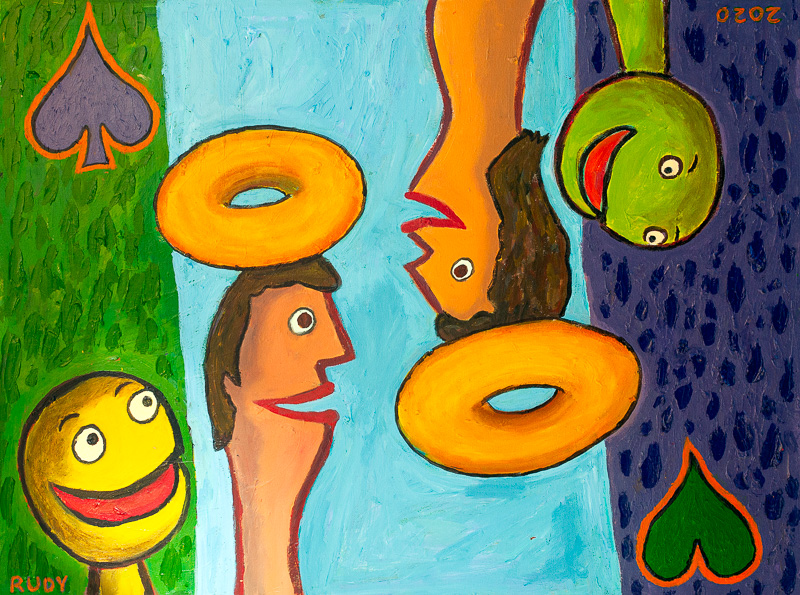
198. The Halo Card
2016. Interview by Liz Argall for Lightspeed webzine.
Q. In your transrealist manifesto you cited the importance of organically finding a story, what might be described as sketching rather than plotting. I’m intrigued to see how many of your paintings are part of your novel writing process. Could you tell us a bit more about how your visual arts practice and writing practice interweave and feed into each other?
A. It’s the left-brain / right-brain thing. Part of my mind fabulates tales and thinks in words. Another part of my mind sees images and dreams up flash. It’s useful to do a drawing or even an oil painting that relates to whatever might be in one of of my upcoming chapters or stories. The paints and canvas do a lot of the work. I shove the colors around and see what I get. By the way, you can see my paintings at www.rudyrucker.com/paintings. Of course, if I can get loose, my writing can be that way too. Sometimes I’ll be tempted to go with a completely crazy and out-there scene, even though, in the current terms of my story, it doesn’t make sense. Turns out it’s almost always better to go with that impulse, and to do the gnarly scene. You and the readers want to have fun and to see wild things. And you can patch in an explanation later. Another lesson from painting is that revisions are easy. You can always paint over a fence or daub in a tentacle. It’s just paint, it’s just words.
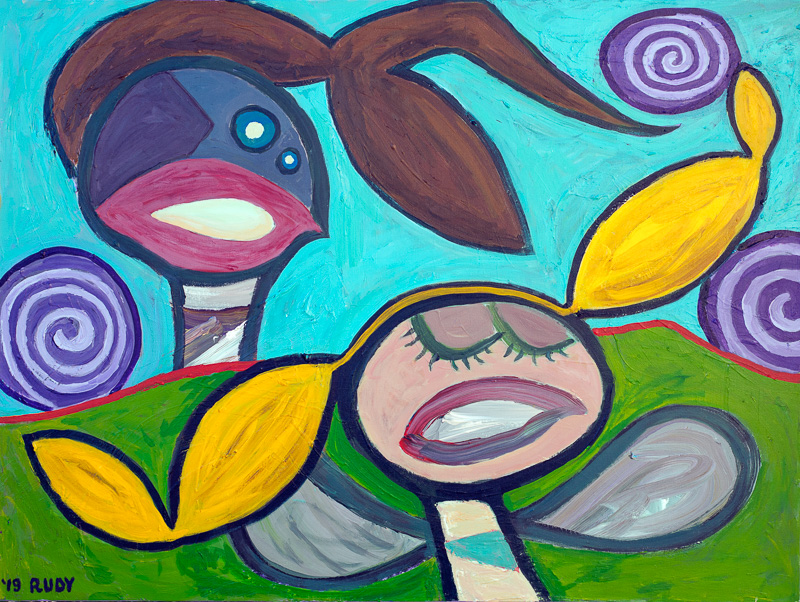
176. Ponytails
2019. Interview by Jeff Somers for B&N SciFi & Fantasy Blog
Q. You also paint, and have received notice for your artwork, which favors surreal sci-fi themes. Are there connections between your painting and your writing?
A. I started painting in 1999 because I was writing a historical novel, As Above, So Below, about the life of the artist Peter Bruegel. I wanted to get a sense of what it’s like to paint. Over time I got to enjoying it more and more. I’ve done almost a hundred and seventy paintings by now. I’m not a great draftsman. But with paint, you can push it around and layer it until it looks like what you want. And then of course you ruin it, and fix it, and ruin it again, and fix it, and eventually you stop.
I like how painting is completely analog. No keyboard and screen. Smearing paint on a canvas. I love it. When I’m unsure about an upcoming scene in a novel, I do a painting that relates to it. Not an exact representation, more like an evocation. Like dreaming while I’m awake. Writing is like dreaming, too. You get out of your way and type.
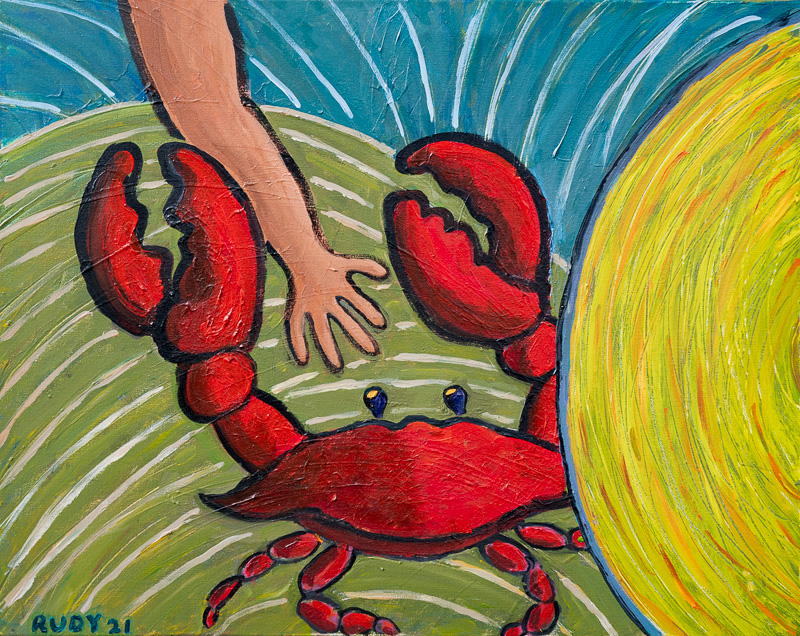
216. Calder Grabs Crab
2019. Interview by Robert Penner for Big Echo ezine
Q. Since I mentioned Blake it might be a good moment to talk about the relation between what you write and what you paint. Could you could say a few words about working across media? How does that kind of play across forms shape your ideas?
A . I think it’s the attitude that’s the important thing. The specific ideas - well, I always just think about the same few things, whatever I’m doing. Sex, gnarl, color, sounds, and the now. I’m here in this rich, amazing reality and - I can’t believe it! My family teases me. “Be quiet, Rudy. You always say that.”
So, okay, I have no mind. It’s my attitude that’s the key. What kind of attitude is needed in order to write, or paint, or take photos, or to assemble a zine from arbitrary grunge mailed in by strangers?
Be loose. Spontaneous bop prosody. Forget yourself. Keep it bouncing. Ruin it, fix it, ruin it again. Make it fun. Revise, revise, revise. God is in the details.
Painting has made some of these practices clearer to me. Like the whole concept of painting over an awkward patch - yeah. And the importance of popping the colors and working the chiaroscuro.
If I’m painting to match a sketch, it’s a drag, and it doesn’t really work. It’s better when I’m mindlessly dabbling, just following the shapes and the colors, and letting my brush loose. Ditto for writing. I don’t worry too much about outlines. I prefer surprise. If the action takes over, and the chracters are talking, and I’m dreaming while I’m awake, and transcribing what I see - that’s when it’s good. I’m in it so deep that I’m gone.
All paintings Copyright © Rudy Rucker 2022. See my paintings page for more info.








